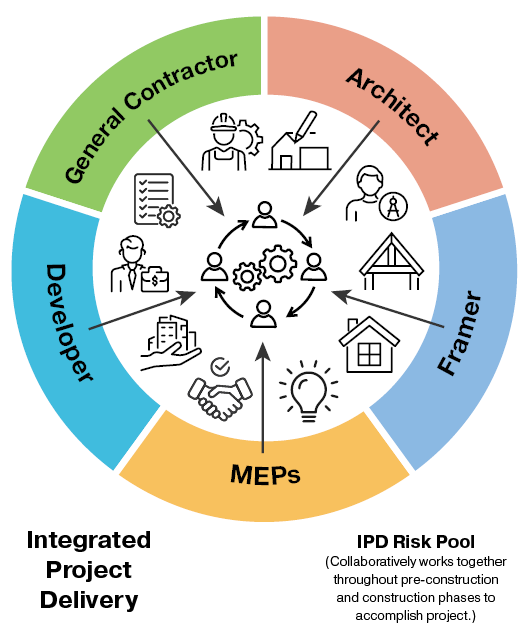Stepping Into the Future of Construction
An Introduction to and Initial Thoughts on Integrated Project Delivery
By Chris Tatge

The first time I heard the phrase “integrated project delivery” was at lunch with a forward-thinking developer who was looking for a way to improve the process. I’ve spent years in the construction industry, working on projects of all sizes and navigating all the usual obstacles—communication breakdowns, budget overruns, and last-minute design changes that throw a wrench into an otherwise smooth process. I have had a lot of success gracefully navigating these things. When I received the invitation to participate in an IPD project, I had a lot of learning to do. We are not very far along in the process, but so far, it’s looking like a great way to build.
IPD, Integrated Project Delivery, is a project delivery method that brings together the owner, architects, engineers, contractors, and key stakeholders from the very beginning. Instead of working in silos on a project, all parties sign a multi-party agreement, and share risks and rewards. That means that if the project succeeds, everyone benefits. If it runs into issues, the group shares in taking responsibility.
I was invited to participate in the “risk pool,” a shared financial incentive structure designed to align the interests of key project participants. In my case, it included the architect, developer, general contractor, MEPs, and me. Instead of each party working in isolation to maximize their own profit, the risk pool ensures that everyone shares in both the rewards and the risks of the project. This model fosters collaboration and accountability, reducing conflicts that often arise in traditional construction delivery methods.
The risk pool works by having the key stakeholders agree to contribute a portion of their potential profits into a collective pool. The amount contributed is determined during the initial agreement phase, with each party committing to shared financial incentives based on project outcomes.
If the project meets or exceeds the established goals for cost, schedule, and quality, the participants earn back their full contribution, often with additional bonuses. However, if the project underperforms—whether due to cost overruns, delays, or design flaws—stakeholders lose a portion of their pooled profits. This structure ensures that everyone involved has a vested interest in maintaining efficiency, solving problems early, and working collaboratively rather than shifting blame.
For example, consider a $50 million construction project involving an owner, an architect, and a general contractor. If they agree to contribute their expected profits into the risk pool, the final payout depends on overall project performance. If the project is completed successfully—on time and under budget—each participant earns back their full share, plus a large portion of the savings. If unexpected issues arise and the project goes over budget, the risk pool absorbs the financial impact, and stakeholders see a reduction in their payouts.

The effectiveness of the risk pool lies in its ability to create a unified team mindset. Instead of working in silos and protecting their individual interests, teams collaborate with the common goal of delivering the best possible outcome. By sharing both risk and reward, IPD incentivizes proactive decision-making, transparency, and efficiency, ultimately leading to fewer disputes, reduced waste, and higher-quality construction projects.
You might be thinking, what exactly is the upside here? I need to put my profits at risk for some kind of potential bonus? Well, sort of. In participating, I do put my profits at risk, but, I am guaranteed to have my real costs covered. Real costs include not just wages, equipment rentals, and supplies, but also wear and tear on equipment, office overhead, and more. There are some other really great things about the process, such as:
It relies heavily on upfront design and preconstruction planning. I’m in the room from the very beginning of the design process. I get an equal voice in the way details are drawn, the size of the exterior decks, the way the corridor is framed. Although, because of the shared risk, I am inclined to see things from every point of view instead of serving my own interests.
I don’t have to spend time estimating ten jobs to win one. It’s guaranteed work. We all have our own processes for chasing jobs. Mine varies depending on my workload, and I will admit to occasionally square footing a job and sending it out. In the case of IPD, I can do an accurate takeoff one time. Rather than making sales calls, I can use my resources to focus on more important things like project management.
It’s a great opportunity to build relationships with developers and general contractors. There’s a lot of trust involved in making one of these projects work. It relies heavily on the personalities of the company leaders in the risk pool. Developers and GCs are therefore incentivized to bring back team members on projects that have worked well for more projects. Additionally, because a successful IPD job can realize 10 to 15% savings off the estimated cost to build, the developers who utilize IPD will be able to offer their investors a better return.
It changes the culture on the jobsite. For example, if the plumber and I are sharing in the same pool of realized profits, I am incentivized to tape his exterior wall penetrations while I’m up in a lift installing windows. The mechanical trades might decide to have one apprentice install all of the hangers in the corridor instead of each trade installing their own hangers. It creates the right conditions for working together in a way that a lot of us aspire to do. No more “screw the next guy” mentality. Their success is your success in a very real financial sense.
As I continue moving through this project, I have learned that IPD isn’t just another contract structure—it’s a shift in mindset. It challenges the old ways of doing things and forces us to think beyond our individual roles. The more I engage with the process, the more I see how it creates a culture of trust, accountability, and shared success. It requires a leap of faith, and yes, there’s risk involved. But the benefits—guaranteed work, deeper collaboration, and a more efficient way to build—are hard to ignore. If this project goes the way I think it will, I can see IPD becoming a major part of the future of construction, and I’m excited to be along for the ride.
